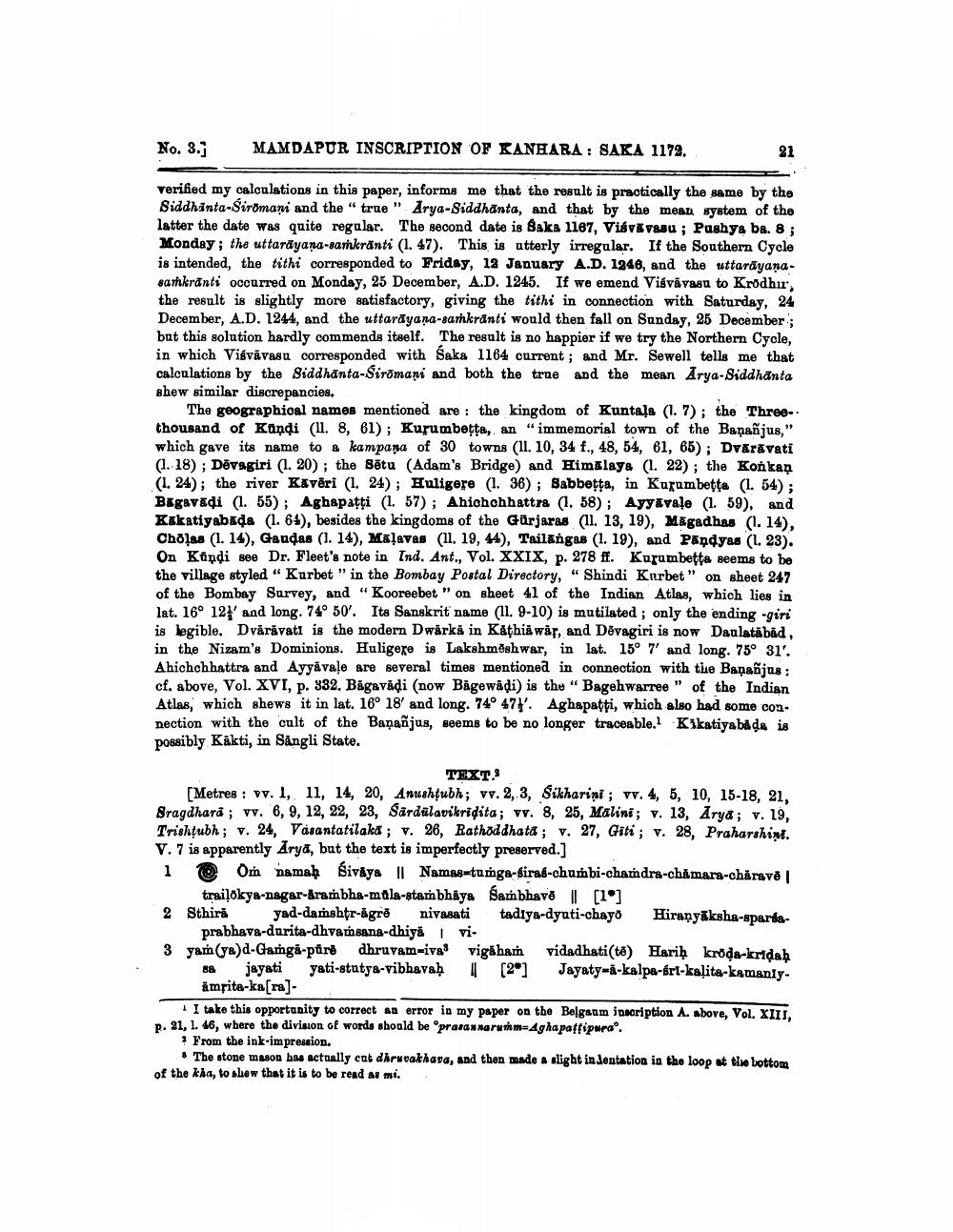________________
No. 3.
MAMDAPUR INSCRIPTION OF KANHARA : SAKA 1172.
21
verified my calculations in this paper, informs me that the result is practically the same by the Siddhinta-Siromani and the "true" Arya-Siddhānta, and that by the mean system of the latter the date was quite regalar. The second date is Saka 1167, Visvivasu; Pushya ba. 8; Monday; the uttarayana-sankranti (1. 47). This is utterly irregular. If the Southern Cycle is intended, the tithi corresponded to Friday, 12 January A.D. 1946, and the uttarayanasathkranti occurred on Monday, 25 December, A.D. 1245. If we emend Visvivasu to Krodhur, the result is slightly more satisfactory, giving the tithi in connection with Saturday, 24 December, A.D. 1244, and the uttardyaņa-sankranti would then fall on Sunday, 25 December; but this solution hardly commends itself. The result is no happier if we try the Northern Cycle, in which Vigvāvasu corresponded with Saka 1164 current; and Mr. Sewell tells me that calculations by the Siddhanta-Siromani and both the true and the mean Arya-Siddhanta Bhew similar discrepancies.
The geographical names mentioned are: the kingdom of Kuntala (1. 7); the Three thousand of Kandi (11. 8, 61); Kurumbetta, an "immemorial town of the Banañjus," which gave its name to a kampana of 30 towns (11. 10, 34 f., 48, 54, 61, 65); Dväravati (1. 18); Dėvagiri (1. 20); the Sētu (Adam's Bridge) and Himalaya (1. 22); the Konkan (1. 24); the river Kávēri (1. 24); Huligere (1. 36); Sabbetta, in Kurumbetta (1. 54); Bagavadi (1.55); Aghapatti (1. 57); Ahichchhattra (1. 58); Ayyavale (1.59), and Kakatiyabada (1. 64), besides the kingdoms of the Gurjaras (11. 13, 19), Māgadhas (1. 14), Cholas (1. 14), Gaudas (1. 14), Malavas (11. 19, 44), Tailangas (1. 19), and Pandyas (L. 23). On Kündi see Dr. Fleet's note in Ind. Ant., Vol. XXIX, p. 278 ff. Kurumbetta seems to be the village styled “Kurbet" in the Bombay Postal Directory,“ Shindi Kurbet" on sheet 247 of the Bombay Survey, and “Kooreebet " on sheet 41 of the Indian Atlas, which lies in lat. 16° 12V and long. 74° 50'. Its Sanskrit name (11. 9-10) is mutilated ; only the ending.giri is legible. Dväravati is the modern Dwarki in Käthiå wår, and Dévagiri is now Daulatábåd, in the Nizam's Dominions. Huligere is Lakshmishwar, in lat. 15° 7' and long. 75° 31'. Ahichchhattra and Ayyavale are several times mentioned in connection with the Banaõjus : cf. above, Vol. XVI, p. 932. Bagavadi (now Bågewädi) is the "Bagehwarree" of the Indian Atlas, which shews it in lat. 16° 18' and long. 74° 47'. Aghapatti, which also had some con. nection with the cult of the Baņañjus, seems to be no longer traceable. Kikatiyabåde is possibly Kakti, in Sångli State.
TEXT. [Metres : vv. 1, 11, 14, 20, Anushţubh; vv. 2, 3, Sikhariņi; vv. 4, 5, 10, 15-18, 21, Sragdhara: vv. 6, 9, 12, 22, 23, Sardulavikridita; vv. 8, 25, Malini; v. 13, Arya; v. 19, Trishtubh ; v. 24, Vasantatilaka ; v. 26, Rathoddhata ; v. 27, Giti ; v. 28, Praharshişt. V. 7 is apparently Arya, but the text is imperfectly preserved.] 1 Om namaḥ śivāya || Namas-tuga-firas-chunbi-chandra-chåmara-chåravě |
traiļokya-nagar-Arambha-mola-stam bhiya Sambhavo || [1] 2 Sthiră yad-damshtr-agro nivasati tadiya-dyuti-chayo Hiraṇyāksha-sparda
prabhava-durita-dhyamsana-dhiyvi3 yam(ya)d-Gamga-paro dhruvam-iva vigähar vidadhati(të) Hariḥ kroda-kridah
38 jayati yati-stutya-vibhavaḥ 1 [2] Jayaty-ä-kalpa-ért-kalita-kamanly. åmpita-ka[ra].
I take this opportunity to correct an error in my paper on the Belgaum inscription A. above, Vol. XIII, p. 21, 1. 46, where the division of words should be prasaunaruum=4gha paffipura.
? From the ink-impression.
• The stone mason has actually cat diruoakhara, and then made a slight in Jentation in the loop at the bottom of the kha, to show that it is to be read as mi.




